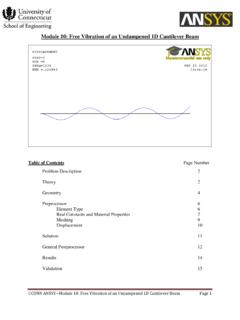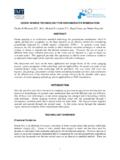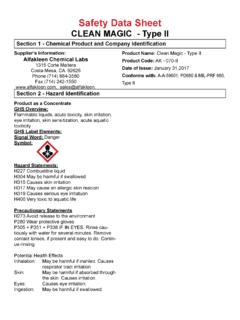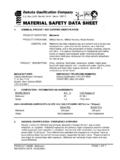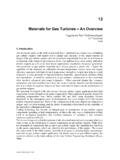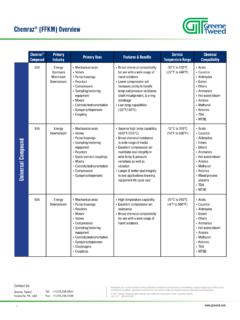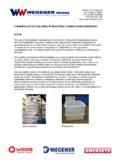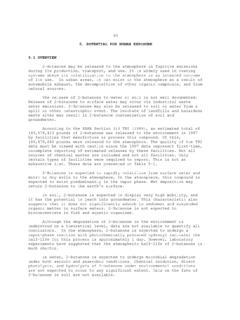Transcription of Overview of Chromium(VI) in the Environment: …
1 1 1-5667-0608-4/01/$ +$ 2004 by CRC Press LLC 1 Overview of chromium (VI) in the environment : background and History James Jacobs and Stephen M. TestaCONTENTS to the chromium (VI) and Chemical Overview .. Perspective .. and Properties .. and Use of chromium .. Production Production .. Paint .. Stainless Steel .. Furnace Tanning and Dying Photography .. Specialized Steels .. Processing and 19 Page 1 Thursday, July 15, 2004 4:59 PM 2 chromium (VI) Handbook Adverse Environmental Effects from Use and Disposal of chromium .. 19 Bibliography .. 20 chromium (Cr) is one of the world s most strategic and critical materialshaving a wide range of uses in the metals and chemical industries.
2 Cralloys enhance metal resistance to impact, corrosion, and oxidation. Cr isused in stainless steel and noniron alloy production for plating metals,development of pigments, leather processing, and production of catalysts,surface treatments, and in refractories. Cr occurs in various oxidationstates, of which chromium (VI) [Cr(VI)] is a suspected carcinogen and apotential soil, surface water, and groundwater contaminant. Cr(VI) mayalso occur in the natural environment , but human-caused Cr(VI) contam-ination has recently been the focus of much scientific discussion, regulatoryconcern, and legal to the many industrial uses of Cr(VI) and an active industrialbase, California and other urbanized states have sites with Cr(VI) contam-inant problems.
3 Drinking water supply wells and water sources areaffected by Cr(VI). What is common to many Cr(VI) sites are questionsthat continue to arise regarding the safety of the drinking water with most environmental challenges, questions of science compete withemotional responses and financial interests. There is still uncertaintyregarding what daily dose of Cr(VI) is considered toxic and what ingestionlevel is define the current state of technical knowledge of Cr(VI), the Ground-water Resources Association of California ( ) presented a Cr(VI)symposium in Glendale, California on January 25, 2001. At this symposium,national experts discussed the science, regulatory policies, and legal issuesassociated with this controversial pollutant.
4 Based on disagreement on eventhe most basic of scientific points, such as safe levels of Cr(VI) to consume,it became apparent that Cr(VI) is a topic of both great importance andwidespread Independent Environmental Technical Evaluation Group (IETEG), avolunteer research organization located in Point Richmond, California, wascreated in 1997 to objectively review scientific and engineering informationconcerning controversial environmental issues. The IETEG s first project was MTBE: Effects on Soil and Groundwater Resources , a CRC Press book publishedin 2000. The project was started in early 2001 to objectively evaluate Cr(VI)issues. The IETEG group is multidisciplinary and includes geologists, engi-neers, toxicologists, lawyers, regulators, and others employed in environ-mental consulting, contracting companies, environmental equipment andAu: Ok?
5 Page 2 Thursday, July 15, 2004 4:59 PM Overview of chromium (VI) in the environment : background and History 3product manufacturers, water purveyors, law firms, and academia. Theseenvironmental professionals are specialists in the assessment and cleanupof soil, groundwater, and air, including environmental compliance, legal andregulatory issues, and the design of water treatment equipment. Given thelevel of misinformation on Cr(VI), this book was prepared to help facilitatea rational approach to assuring the quality of our drinking water suppliesthat may contain Cr(VI). to the chromium (VI) Problem Each contaminant has a unique set of characteristics and issues that mustbe evaluated to proceed with more detailed remediation efforts or develop-ing public policy.
6 These factors include persistence in groundwater, taste andodor thresholds, health risk, transport and fate, current laboratory analyticalmethods, groundwater remediation, and regulatory issues. For Cr(VI), eachof these factors will be evaluated in more detail below and in this volume schapters. Exposure Pathways For some, a significant health concern is the possible adverse effects of humaningestion of Cr(VI) in drinking contaminated groundwater or surface is still being debated within the scientific community. Dermal contactthrough bathing or washing in Cr(VI)-contaminated water is another exposurepathway. Chromate (CrO 42 ) is a mineral containing the chromate ion, Cr 4 - 2 .An example of chromate is potassium chromate, K 2 CrO 4.
7 Chromates can enterthe bloodstream through breaks in the skin. CrO 42 blood poisoning occurswhen CrO 42 destroys red corpuscles. Inhalation is also an important humanexposure pathway; however, it is less likely to be associated with exposure toCr(VI)-contaminated soils and groundwater and more likely associated withindustrial processes such as welding, cutting, heating of Cr alloys, and work-related dermal exposure, chromated copper arsenate (CCA) pressure-treatedlumber is ubiquitous in residential areas. This green-colored pressure-treated lumber is used for building residential decks, picnic tables, swingsets, and other play structures. Since January 1, 2004, the United StatesEnvironmental Protection Agency (USEPA) has banned the use of CCA-treated lumber for new residential use.
8 The exception for residential usewill be permanent wood foundations. The USEPA is not banning the useof millions of CCA-treated wood products already in backyards and wood will still be available for industrial and agricultural low pH rain or fruit juice (orange juice and lemon juice), the chromium Page 3 Thursday, July 15, 2004 4:59 PM 4 chromium (VI) Handbook can be leached off the wood surface. For those concerned about this possi-bility, coating that play set or picnic table with an appropriate penetratingoil every two years will minimize the potential for leaching and adversedermal contact (Morrison, 2004). Physical and Chemical Characteristics chromium is rarely found as a free metal in nature. A clean surface of Crmetal reacts strongly with the atmospheric oxygen (Kohl, 1967).
9 However,the reaction stops quickly owing to the formation of a strong, dense, andnonporous Cr(III) oxide (Cr 2 O 3 ) surface layer, which is estimated to be oneto three formula units thick. chromium oxide passivates the metal from anyfurther reaction with oxygen. This is why Cr does not corrode and why itretains its metallic (III) oxide is among the ten most abundant compounds in the Earth scrust. Cr, a solid at room temperature, generally reacts with halogen gasessuch as fluorine at high temperatures of 400 C and pressures of 200 to 300atm. Cr also reacts with the other halogen gases such as chlorine, bromine,and iodine to form a variety of brightly colored compounds. Cr metal dis-solves in dilute hydrochloric acid and sulfuric acid.
10 Cr does not appear toreact with nitric acid, most likely owing to the result of passivation by surfacechromium oxides. Many of the Cr compounds are is one of the chief ingredients in mineral and metallic colors,being responsible for the color of some gem tones. Among the gem tonescolored by Cr are emeralds, ruby, alexandrite, chrome garnet, and s physical and chemical characteristics remained largely a lab-oratory curiosity for about hundred years from 1800 to 1900. Small amountswere used to harden steel alloys and its numerous compounds were usedin many different industries. A rapid increase in Cr use occurred between1915 and 1930, when Cr became a leading industrial metal, along with iron(Fe), copper (Cu), aluminum (Al), tin (Sn), lead (Pb), and nickel (Ni).


